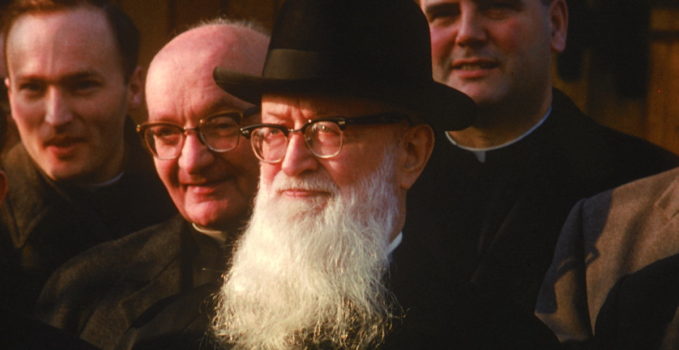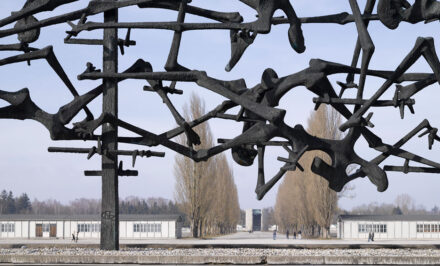Ignacio Serrano del Pozo via www.schvivo.com
All the members of the Schoenstatt Family have got to know the moments when mottos and slogans have been celebrated as a road map. Hardly had the Founder died in 1968, when Bishop Tenhumberg invited the Movement to be “a letter of recommendation for its father”. He was alluding to a passage in St Paul’s letter to the Corinthians in which he wrote that they were meant to be a letter from Christ, written not in ink, but in the spirit. In 1985, when the Family celebrated Fr Kentenich’s hundredth birthday, it said: “Your covenant, our life”. St John Paul II challenged us: Canonise him yourselves. In the context of the jubilee of foundation in 2014 we said: “Your covenant, our mission”. In 2015 Pope Francis reminded us: “You know that a charism is not a museum piece that is kept untouched in a cabinet in order to be admired and nothing else. Faithfulness, keeping a charism pure, does not mean containing it in a prescribed bottle as though it is distilled water, so that it cannot be dirtied by the world around. No, a charism does not prove itself by being protected, it has to be opened and allowed to go out, so that it comes into contact with reality, with people, with their needs a problems.” —
Nevertheless, fifty years on, when we have to take stock, many feel that the mission for which the Movement has accepted responsibility does not show sufficient strength and expansion. It is true that in the last years strongly apostolic initiatives have been developed, for example, in Kentenich schools and pedagogical study centres in the educational field, such as Maria Ayuda in Chile, or the centre for the rehabilitation of youthful offenders in Paraguay. It is also true that a network of more than two hundred shrines that circle the world as places of grace has been built, and a strong campaign of the Pilgrim Mother in hundreds of countries has developed. Both are a tremendous gift to the Church, and both have already assimilated every spirituality. Finally, it is impossible not to rejoice over the spiritual contribution of dozens of spiritual sons and daughters of Fr Kentenich, who from heaven reveal a “triumphant Schoenstatt”: Joseph Engling, Karl Leisner, Sr Emilie Engel, Mariao Hiriart, Hernan Alessandri …
We have still not managed to develop an adult childlikeness
All this and more gives rise to a feeling of dissatisfaction (the voices of souls) with what has been brought about, and jabs us like a thorn. The lack of larger currents of life after the death of the founder, which is to some extent something our Schoenstatt Family takes for granted, and living the “glories of times past” in one jubilee after another, and even more significantly, the inability of us Schoenstatters to build up a new social order, or to form our culture through our charism, are the pin-prick that causes us to ask why we cannot be more courageous and creative with our suggestions for evangelisation.
The quick answer to these questions could be that there is a lack of depth to the covenant of love in its many and varied dimensions: In the depth to the Blank Cheque and Inscriptio, in the height to the Blessed Trinity. However, I would like to attempt to offer a different answer.
I think that the key to explain a creative resultant with limited scope and limited brisance to a large extent consists in the fact that fifty years after the death of the founder we still have not understood how to develop an adult childlikeness that is able to accept his legacy and to increase it. What Pope Francis said to the Church in Chile: “the Church wants you to prove that you have come of age and that you are spiritually mature” – could also be his advice to us Schoenstatters.
In actual fact, instead of mature childlikeness, an infantile childlikeness, or a pubertal childlikeness, dominates. What does that mean? Even if there is danger of drawing a caricature in order to highlight the point in question, we could describe the attitude in question as follows:
Infantile childlikeness – burying the talent
What is infantile childlikeness? Infantile childlikeness distinguishes itself with a permanent delight and dazzlement when faced with the powerful figure of the Father and Founder. Just like a child sees his or her Papa naively as a superhero who can provide an answer to everything, some seem to see Fr Kentenich in this light. From this point of view there seems to be no better test of being a true Schoenstatter than the measure of our effusive admiration and devotion to the founder. The problem is that this view is greatly romanticised, which at times is even an imaginatively laden one-sidedness that only sees the dizzy heights of the person who always followed God’s plans faithfully and became a radiant transparency of God’s fatherliness, even in the darkest moments in the concentration camp or exile. Sometimes it is innocence, sometimes ignorance, but if you know no other interpretation and suggestion, Kentenich is given an unmerited originality and uniqueness.
It is true to say that behind this infantile attitude there is a lot of love, but it is precisely this attitude that makes Kentenich into a saint to be adored, and an untouchable museum piece. In this scenario it seems that our greatest and best contribution to the mission consists in repeating the same features and attitudes of Fr Kentenich time and again, irrespective of every context and criticism.
Behind this infantile attitude there can often be the attitude of the frightened servant in the parable of the talents who buries the legacy in order preserve its value and prevent any loss.
Pubertal childlikeness – to sell the original talent
These people tend to think that Schoenstatt lacks the radical nature of other charisms and Movements, and that we have to do things differently today, because much that Kentenich said or wrote has lost its effectiveness over the years.
To take up the Biblical image we have already used, this attitude multiplies the talents, but only by selling the original coin.
If the infantile attitude leads to a certain rigidity, this one leads more than once to fragmentation and superficiality.
Adult childlikeness – multiply the talents
At this point I want to suggest a third attitude that could contribute to “multiplying the talents I have received”. What matters is living our childlike relationship to the founder as an adult. The first two attitudes are normal and understandable in the first phase of the foundation, but we should be able to expect adult childlikeness in this new period. This attitude includes three qualities that I want to summarise in the following concepts: adopt, take on the costs and risks, and share these costs and risks with others.
In actual fact it is the first task of a child who has become an adult to take on: To accept that the Father is behind us and we are on the front lines. That is to say, it now depends on us to take on responsibility for the limitations presented by life, and for their management, as well as the administration of his tasks and goods. With regard to Kentenich what matters is to accept his life and his work, with all its light and shadows. Many things he did are questionable, and some of what he said is poor, but this in no way reduces the gift of himself and our experience of his fatherhood as the way, the expression and safeguard of our covenant with God. That is the great richness and essence of his charism, which we have to make our own.
This means that we have to recognise that taking up this legacy is not free of its costs and risks. This realism is part of maturity. In Schoenstatt’s terminology the costs are always made in the currency of contributions to the capital of grace. The risks are leaps of faith into Divine Providence.
Expressed more simply, A mature attitude implies, first of all, asking oneself in practice which part of the legacy I am prepared to accept, which burden of taxation I am prepared to pay, and what I will not pick up, or what I have to separate myself from, with all the pain this includes. There is no place for “Schoenstattism”, of using emotional slogans or quoting theoretical treatises. What matters is obeying God’s plan. The Father can ask us to look after our sick wife, and in this way to bear witness to the cross of pierced human love, or to found Schoenstatt in Southeast Asia in order to start a new wave of the Movement. In both these instances, as well as in all other possible circumstances, an adult attitude requires me to ask how I have prepared myself to take up the tasks that make it possible for me to carry on our father’s legacy.
A final characteristic I want to suggest, in order to adopt a mature attitude as our father’s child, is to share the costs and risks with others in the Family. We are not the only heirs. … It is true that this includes conflicts, but it can also mean that some brothers or sisters will withdraw from their responsibility. Nevertheless mature childlikeness also implies a mature relationship to brothers or sisters. What matters is to understand that sharing the heritage means not only dividing it up, but also diversifying what has been received in view of more richness and dynamism. This requires a large dose of generosity, because the best initiatives will often not be ours, but just as seldom the common responsibility.
How are we to react?
On 15 September 1968 many heard it said: Our father has died”. The question that arises fifty years later is: What is the practical significance of those words to us, his legitimate heirs? How do we want to react? Will people be able to say that we are faithful sons and daughters who bring joy to their father, and who passed on his legacy fruitfully?
Published and translated with the permission of the author
Original: Spanish. Translation: Mary Cole, Manchester, UK














